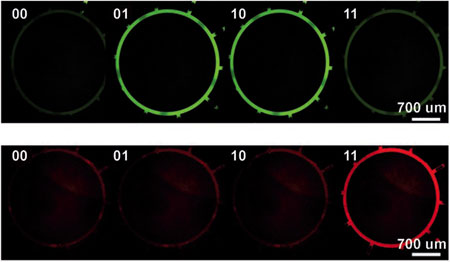| Posted: Dec 05, 2007 | |
Towards wet computing |
|
| (Nanowerk Spotlight) The human body so far is the ultimate 'wet computer' - a highly efficient, biomolecule-based information processor that relies on chemical, optical and electrical signals to operate. Researchers are trying various routes to mimic some of the body's approaches to computing. Especially research related to molecular logic gates is a fast growing and very active area. Already, common logic gates, which are used in conventional silicon circuitry, can be also mimicked at the molecular level. Chemists have reported that a molecular logic gate has the potential for calculation on the nanometer scale, which is unparalleled in silicon-based devices. The general character of the concept of binary logic allows the substitution of electrical signals by chemical and optical signals, which for example opens access to a vast pool of photoactive molecules to be used for the purpose of molecular logic. Molecular logic gate structures using fluorescence changes have been studied intensively using various inputs, such as pH, metal ions, and anions. Now, South Korean scientists using solutions of fluorescent sensor molecules - and, for the first time, proteins - have developed the first soluble molecular logic gates. By using a microfluidic device, input solutions are routed into a central loop, which is filled with a fluorescent sensor solution. There the solutions mix and, in certain combinations, switch the fluorescence 'output' on or off. | |
| Microfluidic (lab-on-a-chip) systems, consisting of a network of microchannels, are increasingly used in the fields of analytical chemistry and biomedical sciences. These miniaturized chemical analysis systems, requiring only the smallest quantities of reaction solutions (in the picoliter range), are already replacing complex, bulk equipment and can provide simple point-of-care devices. | |
| "With programmable microfluidic systems, an analogy can be drawn with electronic computers" says Dr. JuYoung Yoon: "the microfluidic channels are the wires that distribute the information (reaction solutions), while the reaction chambers or mixers are the logic operators. In our recent study, we constructed a molecular logic gate in a microfluidic system based on fluorescent chemosensors by detecting the changes in intensity as a response to various inputs (pH, metal ions). This system was implemented in a programmable microfluidic device." | |
| Yoon, a professor in the Division of Nanoscience at Ewha Womans University in Seoul, South Korea, together with her colleagues from the university, published her findings in a recent paper in Angewandte Chemie ("Fluorescent Molecular Logic Gates Using Microfluidic Devices"). | |
 |
|
| A half-adder molecular logic gate composed of an XOR gate (green) and an AND gate (red). Top: Fluorescence images of a fluorescein derivative (green) in the presence of two H+ inputs. Bottom: fluorescence images of rhodamine B derivative (red) in the presence of two H+ inputs. (Reprinted with permission from Wiley) | |
| The Korean scientists demonstrated an XOR logic gate (in the realm of digital logic the 'Exclusive-OR' or 'XOR' function can be described verbally as " either A or B, but not both") in a microfluidic system by controlling the pH of a solution of a fluorescein derivative, which was then advanced to a combinatorial circuit, such as a half adder using the fluorescein derivative and a rhodamine B derivative. In this case, the fluorescein derivative emits green light only at neutral pH. | |
| The fluorescein solution was added to the loop in a basic environment so no fluorescence was seen. When either one of two acidic inputs was turned 'on' by injection into the loop, they neutralized the solution – switching on the fluorescence. But when both inputs were injected the pH became too acidic and the solution stopped fluorescing. | |
| Finally, the first example of a molecular logic gate using a protein and Cu2+ ions as inputs was demonstrated, in which a Cu2+-selective fluorescein derivative was employed as the communicating signal material. Copper-binding studies in transferrin (Tf) have been reported because copper is known to play an important role in a number of neurodegenerative diseases, such as Alzheimer's. The Korean researchers set up their microfluidic system with a sensor molecule to monitor the uptake of Cu2+ ions by copper-binding proteins, such as Tf. The inverse output (or negative logic gate) result can be used as an INHIBIT logic gate. | |
| "To the best of our knowledge, this is the first example of a molecular logic gate utilizing a protein as the input" says Yoon. "This particular microfluidic system has potential as a lab-on-a-chip-type sensor for monitoring the Cu2+ ion uptake by copper-binding proteins." | |
| The attractiveness of the Korean researchers' approach is that molecular logic gates in microfluidic systems offer reduced reagent consumption, high throughput, and unprecedented automation. Therefore, this new approach can be considered important progress towards a molecular computing system. | |
 By
Michael
Berger
– Michael is author of three books by the Royal Society of Chemistry:
Nano-Society: Pushing the Boundaries of Technology,
Nanotechnology: The Future is Tiny, and
Nanoengineering: The Skills and Tools Making Technology Invisible
Copyright ©
Nanowerk LLC
By
Michael
Berger
– Michael is author of three books by the Royal Society of Chemistry:
Nano-Society: Pushing the Boundaries of Technology,
Nanotechnology: The Future is Tiny, and
Nanoengineering: The Skills and Tools Making Technology Invisible
Copyright ©
Nanowerk LLC
|
|
|
Become a Spotlight guest author! Join our large and growing group of guest contributors. Have you just published a scientific paper or have other exciting developments to share with the nanotechnology community? Here is how to publish on nanowerk.com. |
|
